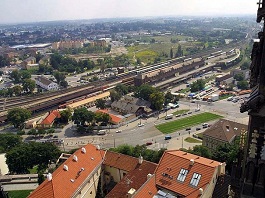
The study admits the possibility of building a station in Brno at two locations
 |
These entities are part of the Committee for the feasibility study of the Brno railway junction and are expected to reach an agreement, which will be communicated to the Ministry of Transport. Once the matter is discussed, it will be forwarded to the government. "We need to look for money in the State Fund for Transport Infrastructure. The question is the future co-financing from the European Union," said Deputy Minister of Transport Tomáš Čoček. Optimistic assumptions for the start of construction are for the relocated station in 2020, and for the central station in 2026, due to spatial and project readiness.
The Brno City Hall stated that the city leadership has requested SŽDC to present the study results to Brno representatives and city district councilors. "According to the commitment in the coalition agreement, the self-government will adopt a position at the Brno City Council within three months of receiving the final conclusions of the feasibility study, based on the results of the feasibility study and the potential opinion of the European Investment Bank. The expected deadline for adopting a position is by January 31, 2018," said city spokesperson Filip Poňuchálek.
The study indicates that Brno definitely needs a new station, as the current one will not be able to handle the anticipated increase in trains, even with modernization. "The discussion is not just about the location of the station, but generally about the organization of Brno and the wider agglomeration. From a broader perspective, it is about the transport arrangement of the region with an impact on Vysočina," Nejezchleb said.
Both new station options are divided into several sub-options based on platform layout and the routing of tracks from Přerov and Veselí nad Moravou. In the case of the relocated station, these two tracks may follow the route of the current Komárov connection or the route of the North-South rail diameter, which would mean they would have an underground station.
For the central station, there are two basic variants based on the minimum curve radii on the platforms. One option has a radius of 300 meters, which is acceptable according to standards, but is not recommended due to comfort and safety concerns. The second option, which would involve the purchase and demolition of Tesko, has a radius of 500 meters. "This one is already very well usable," said Josef Buriánek from SŽDC during the presentation. In the case of the routing of tracks from Přerov and Veselí, tunnels from the Komárov connection to the airport are considered, where a station and track expansion would be created, or just adding a track to the existing line.
The investment range for the individual options varies from 42 to 57 billion crowns, including urban infrastructure. "All variants show positive economic benefits," Buriánek said.
The costs do not include the integration of high-speed rail lines. For the relocated station, there are plans to bring the track from Prague along D1, while for the central station, a system of tunnels in Žebětín, Jundrov, and Žabovřesky leading under the historic center is being considered. "An underground station would be created beneath the station. For the relocated station, one platform would be completed," Buriánek stated.
The English translation is powered by AI tool. Switch to Czech to view the original text source.
0 comments
add comment
Related articles
4
31.08.2020 | In Brno, the competition for the author of the main train station has started today
3
17.06.2020 | Brno councilors approved the preparations for the competition for a new train station
0
28.02.2019 | Children of the Earth are suing the zoning decision regarding the Brno railway station
0
31.05.2018 | The relocation of the main train station to the river has been discussed in Brno for over 90 years
0
09.04.2018 | The Greens will turn to Minister Ťok due to the relocation of the train station in Brno
0
27.03.2018 | The steering committee recommended relocating the main train station in Brno
0
28.02.2018 | The representatives of Brno want a new train station in a relocated position
0
28.02.2018 | The zoning decision for the Brno railway station is delaying requests for interruption
0
18.02.2018 | Research for Brno: The most acceptable is the new train station under Petrov
0
15.01.2018 | South Moravian representatives supported the relocation of the station in Brno to the river
1
15.01.2018 | The Mayor of Brno, Vokřál, supported the construction of the train station in the relocated position
0
12.01.2018 | Supporters of the train station in the center of Brno criticize the region
4
10.01.2018 | Four expert evaluations recommend keeping the train station in the center of Brno
0
09.01.2018 | The Office of the City Architect recommends moving the train station to the Svratka
0
07.01.2018 | The leadership of Brno will conduct a public opinion survey regarding the train station
0
01.12.2017 | Green party calls on mayors from South Moravia to discuss the train station in Brno
4
01.11.2017 | Trams to the relocated station in Brno would run longer than to the city center
0
25.10.2017 | SŽDC will publish the results of the study on the reconstruction of the Brno junction
1
05.10.2017 | The study of the modernization of the railway hub in Brno will be ready on Tuesday
2
03.05.2017 | The study on the reconstruction of the railway hub in Brno will be until autumn
0
27.06.2016 | The feasibility study for the modernization of the station will be next year
1
10.05.2016 | The competition for the future of the center of Brno was won by UNIT architects
0
05.03.2012 | Brno has its first official document that admits to a train station in the center











